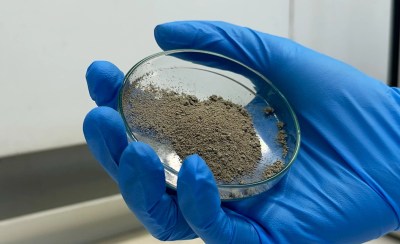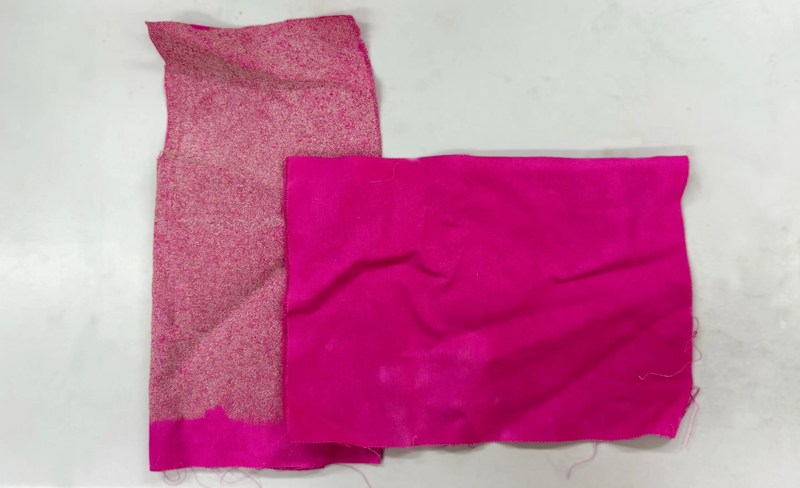We vaguely remember what we believe was a DuPont commercial in the late ’80s or early ’90s touting that one day, they would make clothing that could cool you. And sure, there is clothing that allows heat to escape — fishnet shirts come to mind most immediately — but a group of scientists at Australia’s RMIT University have applied a coating of nanodiamonds to cotton in order to make fabric that goes a step further, drawing heat away from the body.
 While you may be picturing blinged-out blouses, the truth is that nanodiamonds are cheap and non-glittery. They bear the same carbon-lattice structure as regular diamonds, which gives them great thermal conductivity.
While you may be picturing blinged-out blouses, the truth is that nanodiamonds are cheap and non-glittery. They bear the same carbon-lattice structure as regular diamonds, which gives them great thermal conductivity.
In order to create cooling fabric, the scientists combined nanodiamond powder with polyurethane and a solvent, and applied the solution to one side of a sheet of cotton via electrospinning. This technique uses electric force to spin charged threads up into the diameters of fiber. The other side was left uncoated so that it doesn’t draw in heat.
Studies showed that the treated samples released 2 to 3 ºC (3.6 to 5.4 ºF) more heat via the coated side throughout the cooling period. While a couple of degrees may not seem like much, it could mean the difference between using a fan or using an air conditioner to cool off further.
Another application could be to keep buildings from overheating. We’ve seen developments in that area, usually in the form of ultra-white paint.

















Seeing ” treated samples released 2 to 3 ºC (3.6 to 5.4 ºF) more heat “, I had to go check the original source. Sure enough, that nonsensical statement is right from that fluff piece. Maybe something got lost in the translation from Australian.
From a publication calling themselves “New Atlas” no less. The woo is strong with this one.
Gee – microscopic particles of a very hard substance whose relative inertness and longevity are legendary, applied to clothing from whence it can wear off and be inhaled or ingested by people. What could possibly go wrong with this plan?
Might we see the advent of “carbosis” as a new word in English dictionaries?
It will likely come down to particle size. While they call them nano diamonds, they are likely nowhere near the 2.5um size that is the source of miners lung and the like. And on the upside I’d expect the diamond particles to be quite hardy, not breaking into smaller bits.
That said, I’ll be waiting for some time before trying this newfangled stuff. Just in case.
I’d better not find some loiterer leaning against my shop window, wearing a shirt like this…!
This is basically sand paper. Also great in sanding down bus-, train- and taxiseats. And if you wear it inside-out, it will be great at sanding down your nipples, I think. :)
This is actually more like polishing compound than sandpaper. You can rub it against the window all day without seeing any scratches.
Soap will be harder on your nipples than these tiny diamonds.
‘Soap will be harder on your nipples than these tiny diamonds.’
That’s a brand new sentence if I’ve ever heard one.
They claim they are nanoscale particles in the polymer matrix, and the (polymer) fibers are produced by electrospinning, implying the particles themselves are on the order of a few nanometers in size: far smaller than any biological cell, about the size of virus particles. Whether that’s bad or indifferent depends largely on what it does and how it interacts on contact or ingestion. It’s not likely going to be beneficial, however.
Don’t forget to do not clean your glasses with your clothes :)
Oh man, I would absolutely forget this and ruin my lenses immediately.
I wonder if this would allow them to make light reversible jackets that held warmth in during cool months, and then turn it inside out to let heat escape during warmer months. It’s probably oversimplification, but the description sounds almost like a positive relief valve for heat.
> While a couple of degrees may not seem like much, it could mean the difference between using a fan or using an air conditioner to cool off further.
Or the low tech (and free way) way to just remove your shirt.
At least 50% of people probably shouldn’t do that.
Can someone give me an explaination as to the proposed mechanism of this?
Heat will always flow from hotter to colder. I get that clothing would insulate to differing degrees but are they claiming this conducts heat better? Even if it’s “better” than other materials it will still have some finite amount of insulating and so be worse than bare skin.
The only really effective mechanism of cooling humans near
The limits of heat tolerance is the evaporation of sweat. A super porus material could potentially wick more sweat and cool “better” but they don’t seem to be invoking that mechanism here.
Can I also have diamonds on the soles of my shoes?